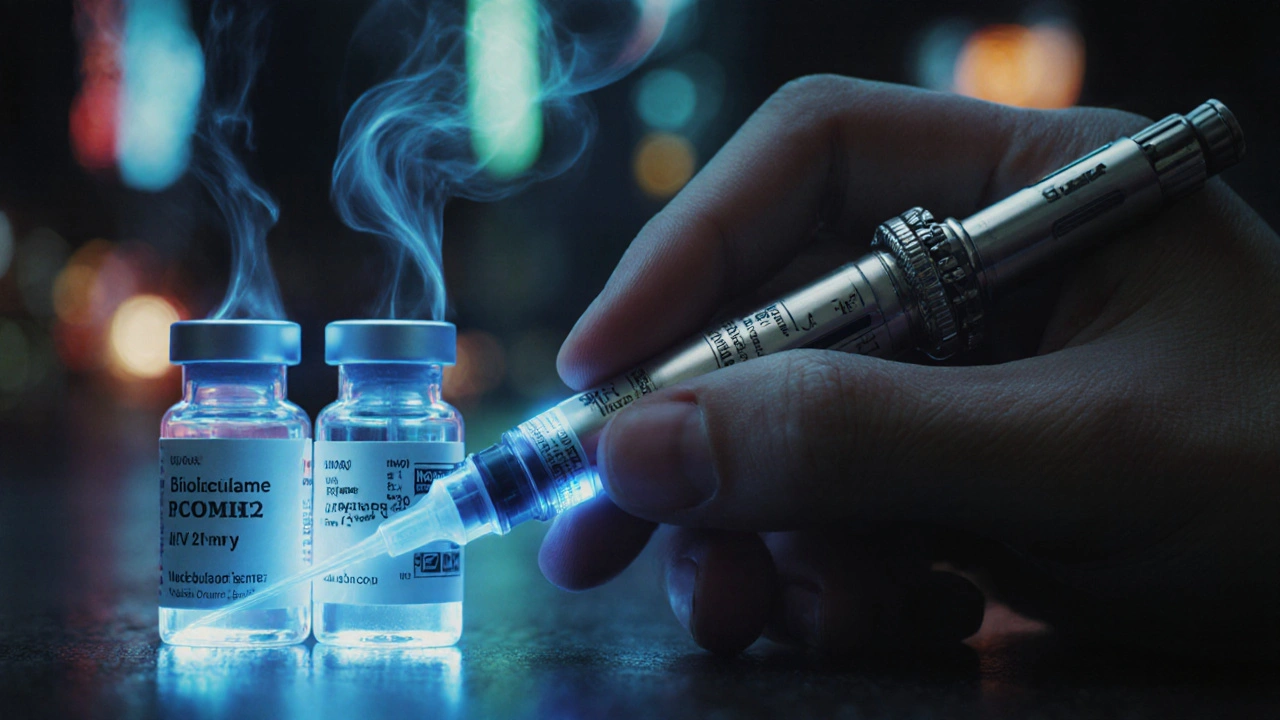Biosimilar Savings Calculator
Calculate Your Savings
See how much you could save by switching to a biosimilar medication.
Your Potential Savings
Did you know? Biosimilars are 15-30% cheaper than brand-name biologics while providing the same clinical benefits. From 2015-2022, biosimilars saved the U.S. healthcare system $31 billion.
Based on data from the article: Switching to a biosimilar can save you hundreds of dollars each month without compromising your health or treatment effectiveness.
When your doctor suggests switching from a brand-name biologic like Humira or Enbrel to a biosimilar, it’s normal to feel unsure. You’ve heard the name, maybe seen it on your prescription, but you’re not sure if it’s the same thing. Is it just a cheaper copy? Could it make you sicker? These questions aren’t just about cost-they’re about trust. And the truth is, the science behind biosimilars is clearer than most people realize.
What Exactly Is a Biosimilar?
A biosimilar isn’t a generic drug. That’s the first thing to understand. Generics are exact chemical copies of small-molecule drugs, like aspirin or metformin. Biosimilars, on the other hand, are made from living cells-yeast, bacteria, or animal cells-and are designed to be highly similar to an already-approved biologic drug, called the reference product. They’re not identical, but they don’t need to be.
The European Medicines Agency (EMA) approved the first biosimilar in 2006. The U.S. Food and Drug Administration (FDA) followed in 2015 with Zarxio, a biosimilar to filgrastim, used to boost white blood cell counts after chemotherapy. Since then, more than 55 biosimilars have been approved in Europe, and 26 in the U.S. By 2023, the FDA had approved 12 new ones in a single year, including four for adalimumab (Humira), a drug used for arthritis and Crohn’s disease.
What makes a biosimilar a biosimilar? It has to match the reference drug in molecular structure, purity, and how it works in the body. Minor differences in non-active ingredients are allowed-like stabilizers or preservatives-but these can’t affect safety or effectiveness. The FDA requires extensive testing: thousands of lab analyses, animal studies, and clinical trials in patients. But here’s the key-they don’t need to repeat every single trial done for the original drug. Why? Because the reference product’s safety profile is already well known.
Are Biosimilars Safe? The Real-World Evidence
Safety is the biggest concern. People worry: What if the biosimilar triggers a stronger immune response? What if it causes new side effects? The answer lies in data-lots of it.
Sandoz, one of the largest biosimilar manufacturers, tracked over 1.3 billion patient treatment days across eight of its biosimilars-things like adalimumab, infliximab, and etanercept. That’s more than a billion days of real people using these drugs, often for years. Another biosimilar, rituximab, has been given to over 1.8 million patients. In every case, the safety profile matched the original biologic.
Immunogenicity-the risk of your body making antibodies against the drug-is a real concern with biologics. But studies show biosimilars don’t increase this risk. In fact, the FDA’s Biosimilars Dashboard states clearly: “Biosimilars have no clinically meaningful differences in safety, purity, and potency from the reference product.” That’s not marketing language. It’s a regulatory standard.
Long-term follow-up is built into the approval process. Regulators don’t just approve a biosimilar and walk away. They require ongoing safety monitoring. Pharmacovigilance systems track every reported side effect, and if something unusual pops up, regulators investigate. So far, nothing has emerged that wasn’t already seen with the original drug.
Do Biosimilars Work as Well?
Effectiveness is just as important as safety. If a biosimilar doesn’t control your arthritis, psoriasis, or Crohn’s disease, it doesn’t matter how safe it is.
Multiple clinical trials have compared biosimilars directly to their reference products. One major study, NCT03729674, looked at disease activity, remission rates, and how often patients had to stop treatment. The results? No meaningful difference. Patients on biosimilars stayed in remission just as long. Their symptoms improved just as much.
Even switching between the reference drug and the biosimilar has been studied. Some patients start on the original, then switch to the biosimilar. Others switch back. A 2024 review in Taylor & Francis concluded: “Switching from reference biologics to biosimilars and vice versa is safe and does not affect efficacy.” That’s not theoretical-it’s based on real patient outcomes.
One patient on MyBiosimilarsExperience.com shared: “Switched from Humira to Amjevita after my insurer mandated it-no difference in efficacy after 18 months, saved me $1,200 monthly.” That’s not an outlier. A 2022 survey found 68% of physicians reported positive experiences with biosimilar efficacy. The data doesn’t lie.

Why Do Some People Still Doubt Them?
Despite the evidence, skepticism remains. Why?
One reason is language. The FDA and EMA say biosimilars have “no clinically meaningful differences.” But originator drug companies often say they’re “highly similar, but not identical.” That’s technically true-but it’s misleading. It makes people think there’s a big gap, when there isn’t. The FDA even called out Genentech in 2018 for marketing practices that confused patients.
Another reason is awareness. Many patients don’t know what biosimilars are. Surveys show low awareness and lingering fears about reduced effectiveness or higher risk. One pharmacist on Reddit said: “I’ve seen zero adverse events from biosimilar switches in my 5 years of hospital practice, but patients often refuse due to misinformation.”
Then there’s the cost factor. Biosimilars are typically 15-30% cheaper than the original. That’s why they’ve been adopted so quickly in Europe, where they now make up 65% of the filgrastim market and 55% of infliximab. In the U.S., adoption is slower-only 35% for filgrastim and 28% for infliximab. Why? Patent thickets, rebates, and pay-for-delay deals keep prices high and limit competition.
What About Switching? Is It Safe?
Many patients wonder: Can I switch from my current biologic to a biosimilar? What if I switch back?
The answer is yes-safely. The FDA updated its guidance in February 2024 to say that switching between a reference product and a biosimilar carries no significant risk. That’s based on more than a decade of data.
There’s even a category called “interchangeable biosimilars.” These are biosimilars that have passed extra tests proving they can be swapped at the pharmacy without the doctor’s involvement-just like generics. As of 2025, several interchangeable biosimilars are available in the U.S., depending on your state’s laws.
Doctors are now trained to use standardized tools to monitor disease activity after a switch. Things like C-reactive protein levels, joint counts, or skin severity scores are tracked over time. If a patient’s condition worsens, it’s not automatically blamed on the biosimilar. It could be stress, infection, or other factors. That’s why proper monitoring matters.

The Bigger Picture: Cost, Access, and the Future
Biosimilars aren’t just about science-they’re about access. Biologics can cost $20,000 to $50,000 a year. For many patients, that’s out of reach. Biosimilars change that.
From 2015 to 2022, biosimilars saved the U.S. healthcare system $31 billion. Projections show they could save another $307 billion by 2030. Globally, the market is expected to grow from $9.3 billion in 2022 to $58.1 billion by 2030.
They’re also expanding into new areas. As of early 2024, 17 biosimilars are approved for cancer treatments-things like trastuzumab for breast cancer and bevacizumab for colorectal cancer. More are coming.
The World Health Organization, EMA, and FDA all agree: biosimilars approved through rigorous pathways are as safe and effective as the originals. That’s not a guess. It’s the consensus of the world’s top regulators.
What You Should Know Before Switching
If your doctor suggests a biosimilar, here’s what to ask:
- Is this biosimilar approved for my exact condition?
- Has it been used in other patients with my disease?
- Will my insurance cover it, and how much will I pay?
- Is it interchangeable? (That means the pharmacy can switch it without calling your doctor.)
- How will we monitor my response?
Don’t assume a biosimilar is inferior. The science says otherwise. And if you’re worried about side effects, keep a symptom journal. That way, if something changes, you and your doctor can tell whether it’s the drug-or something else.
Real-world experience shows that when patients give biosimilars a fair chance, they rarely regret it. The data is clear. The safety profile is solid. The effectiveness matches. And the cost savings? They’re real.
Are biosimilars just cheaper copies of brand-name drugs?
No. Biosimilars are not generic copies. They’re complex biological products made from living cells, designed to be highly similar to an approved reference biologic. They undergo rigorous testing to prove they have no clinically meaningful differences in safety, purity, or effectiveness. Unlike generics, which are exact chemical duplicates, biosimilars can have minor differences in non-active ingredients-but these don’t affect how the drug works in the body.
Can switching to a biosimilar make my condition worse?
There is no evidence that switching from a reference biologic to a biosimilar makes a condition worse. Multiple studies, including long-term real-world data from over a billion patient treatment days, show that disease control, remission rates, and side effect profiles remain consistent after a switch. The FDA and EMA both confirm that switching is safe. If symptoms change after a switch, it’s more likely due to other factors like stress, infection, or lifestyle changes-not the biosimilar itself.
Why do some doctors and patients hesitate to use biosimilars?
Hesitation often comes from misinformation. Some originator drug companies use marketing language like “highly similar, but not identical,” which sounds alarming-even though regulators clarify that “no clinically meaningful differences” exist. Patients also have low awareness and fear the unknown. Some doctors, especially those who’ve worked with the original drug for years, may be cautious. But surveys show that 68% of physicians report positive experiences with biosimilars once they’ve used them in practice.
Are biosimilars approved for the same conditions as the original biologics?
Yes. Once a biosimilar is approved for one condition, regulators often allow it to be used for all the same conditions as the reference product-without requiring new trials for each one. This is called extrapolation. For example, if a biosimilar is proven effective for rheumatoid arthritis, it can be approved for psoriatic arthritis or Crohn’s disease too, based on the similarity of the underlying biological mechanisms. This process is backed by the FDA, EMA, and WHO.
How do I know if my biosimilar is interchangeable?
Interchangeable biosimilars are clearly labeled as such by the FDA. They’ve passed extra tests proving they can be substituted at the pharmacy without the prescriber’s involvement, just like generics. Not all biosimilars are interchangeable-only those that meet stricter criteria. Check your prescription label: if it says “interchangeable,” your pharmacist can swap it without calling your doctor. If it doesn’t say that, your doctor must specifically prescribe the biosimilar by name.
Do biosimilars cause more side effects than the original drugs?
No. Clinical trials and real-world data show that biosimilars have the same rate and type of side effects as their reference products. Common side effects like injection site reactions, fatigue, or mild infections occur at similar rates. Serious adverse events-like infections, cancer, or autoimmune reactions-are also no more common with biosimilars. The FDA’s post-market surveillance systems monitor for any unusual patterns, and none have been found.

Kristina Williams
November 18, 2025 AT 22:32Wait, so you're telling me Big Pharma doesn't want us to know this because they're losing billions? 😏 I saw a video on TikTok where some guy said biosimilars are made in Chinese labs with contaminated water and cause weird rashes. I'm not saying it's true, but... why won't they just let us see the factory footage?
Shilpi Tiwari
November 20, 2025 AT 12:08From a pharmacokinetic standpoint, the structural homology and glycosylation profiles of biosimilars are meticulously characterized via LC-MS/MS and CE-SDS, ensuring functional equivalence to the reference biologic. The FDA’s analytical comparability package is far more rigorous than most realize-this isn’t just ‘copy-paste’ chemistry, it’s molecular choreography.
Denny Sucipto
November 21, 2025 AT 01:03Man, I switched from Humira to Amjevita last year after my insurance flipped out. Thought I was gonna die. But guess what? Still hiking, still playing with my kids, still not broke. No magic, no drama-just cheaper medicine that works. Don’t let fear scare you out of saving your wallet.
Holly Powell
November 21, 2025 AT 15:46Let’s be real-this whole ‘biosimilar’ narrative is just regulatory capture disguised as progress. The EMA and FDA are basically rubber-stamping these because they’re pressured by cost-cutting bureaucrats. And don’t get me started on extrapolation-just because it works for RA doesn’t mean it’s safe for Crohn’s. That’s science by spreadsheet.
Emanuel Jalba
November 22, 2025 AT 21:16MY DOCTOR SWITCHED ME WITHOUT TELLING ME 😭 I FELT WEIRD FOR A WEEK AND THOUGHT I WAS DYING. NOW I’M ON A FACEBOOK GROUP FOR ‘BIOSSIMILAR VICTIMS’ AND WE’RE FILING A CLASS ACTION. #BiosimilarBetrayal 🚨💔
Christine Eslinger
November 23, 2025 AT 16:45It’s okay to feel nervous-this stuff is expensive and it’s your health. But the data isn’t just ‘good enough,’ it’s overwhelming. Over a billion patient-days tracked. Zero new risks. The same side effects, the same results, the same hope. You’re not trading safety for savings-you’re unlocking access to something that was once a luxury. Be kind to yourself as you learn.
Louie Amour
November 24, 2025 AT 00:47Oh please. You think some ‘biosimilar’ made in a lab with 30-year-old equipment can match a $50K/year biologic? That’s like saying a Walmart knockoff Rolex is just as precise. The FDA doesn’t test for long-term immune consequences-only what’s convenient. And don’t even get me started on the patent trolls who own these ‘generic’ versions.
Kristi Joy
November 24, 2025 AT 05:08Hey Louie, I know you’re worried-and you’re not alone. But the fact that you’re asking means you care. And that’s powerful. The science is on your side here. Maybe talk to your doctor about the data, not the fear. You deserve to feel safe, not sold to.